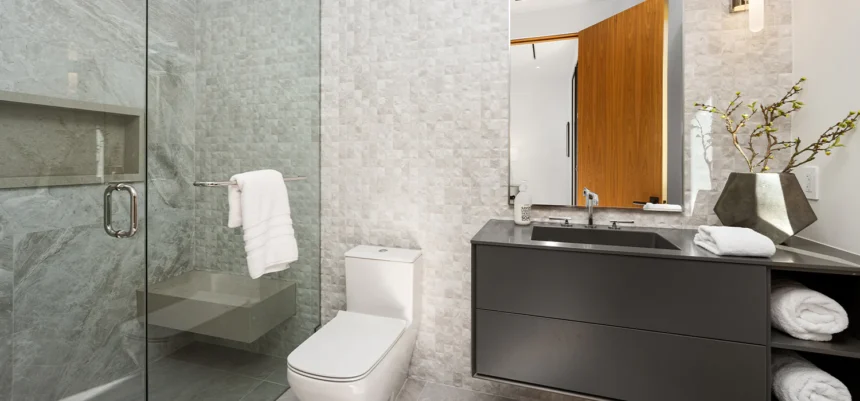Choosing a suitable vanity unit enhances a bathroom’s aesthetics and functionality. Vanity units provide crucial storage solutions and are a focal point in bathroom design. This guide will help navigate the various aspects of selecting the perfect component to elevate bathroom aesthetics.
Understanding the Importance of Vanity Units
Bathroom vanity units play a pivotal role in its design. They offer storage space, help organise essentials, and contribute to the overall look and feel of the space. A well-chosen vanity component can make a bathroom more spacious, organised, and stylish. Understanding their importance is the first step in making an informed decision.
Assessing Bathroom Space and Layout
Before selecting a vanity unit, it is crucial to assess the available space and layout of the bathroom. Measure the dimensions carefully, including the width, depth, and height where the vanity will be placed. Consider the placement of existing fixtures such as toilets, showers, and doors to ensure the component fits comfortably without obstructing movement.
Choosing the Right Style
It comes in various styles to suit different bathroom aesthetics. The component’s style should complement the washroom’s overall design theme. Some popular styles include:
- Modern: Sleek lines, minimalistic design, and neutral colours characterise modern vanity units. They often feature integrated sinks and handleless drawers for a streamlined look.
- Traditional: Traditional vanity units are known for their ornate details, classic hardware, and rich finishes. These components often include intricate woodwork and are ideal for creating a timeless, elegant bathroom.
- Transitional: A blend of modern and traditional features, transitional vanity units offer flexibility in design. They can feature clean lines with subtle decorative details, making them suitable for various bathroom styles.
- Rustic: Rustic vanity units bring a natural, earthy feel to the bathroom. Often made from reclaimed wood or materials with a weathered finish, they add warmth and character to the space.
Material Considerations
Choosing a vanity component’s material is crucial for aesthetics and durability. Different materials offer various benefits and can affect the bathroom’s overall look. Some common materials include:
- Wood: Wood units provide a classic and warm look. Options span from solid wood to engineered wood, each offering different levels of durability and cost. Proper sealing is essential to prevent moisture damage.
- Laminate: Laminate units are affordable and available in various colours and patterns. They are easy to clean and manage, making them a practical choice for busy bathrooms.
- Glass: Glass units offer a contemporary and sleek appearance. They are often used in modern designs and can make a sense of openness in smaller bathrooms. However, they need regular cleaning to maintain their pristine look.
- Stone: Stone units like marble or granite provide a luxurious and durable option. They are ideal for high-end bathrooms but can be more expensive and need careful maintenance to prevent staining.
Selecting the Right Countertop
The countertop of a vanity unit is another critical element that impacts both functionality and style. When choosing a countertop, consider the following materials:
- Quartz: Quartz countertops are highly durable, non-porous, and available in various colours and patterns. They require minimal cleaning and are resistant to stains and scratches.
- Granite: Granite countertops offer a natural, unique appearance with varying patterns and colours. They are durable and heat-resistant but require regular sealing to prevent staining.
- Marble: Marble countertops provide a timeless and elegant look. However, they are porous and can be prone to staining and scratching, requiring careful maintenance.
- Solid Surface: Solid surface countertops are diverse and can mimic the looks of stone or wood. They are non-porous, not hard to clean, and can be seamlessly integrated with the sink.
Consideration for Storage Needs
Storage is a key function of a vanity unit. Assess the storage needs based on the items that will be kept in the bathroom. Vanity components come with various storage options, including drawers, cabinets, and open shelves. Drawers with dividers can help organise smaller items, while larger cabinets are suitable for storing towels and cleaning supplies.
Faucet and Sink Options
The choice of faucet and sink is integral to the overall functionality and design of the vanity component. Consider the following options:
- Integrated Sink: Integrated sinks are seamlessly built into the countertop, offering a clean, modern look. They are also easy to clean and maintain.
- Undermount Sink: Undermount sinks are fitted below the countertop, providing a sleek appearance. They maximise counter space and are easy to clean.
- Vessel Sink: Vessel sinks sit above the countertop and can serve as a noticeable design element. They come in various shapes, sizes, and materials, adding a unique touch to the bathroom.
Choosing the right bathroom vanity unit is essential for enhancing the space’s aesthetics and functionality. By considering factors such as space, style, materials, storage needs, and sink options, it is possible to find the perfect vanity unit that complements the overall design and meets practical requirements. Whether aiming for a modern, traditional, or rustic look, the right vanity unit can transform a bathroom into a stylish and efficient space.






